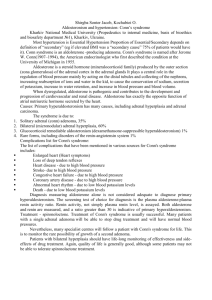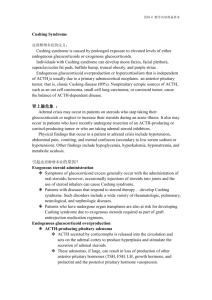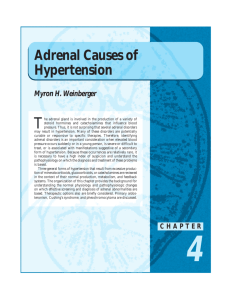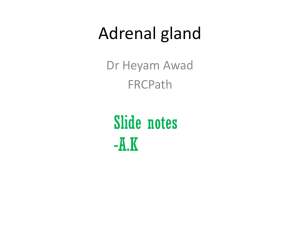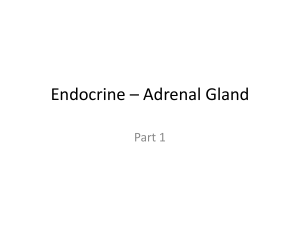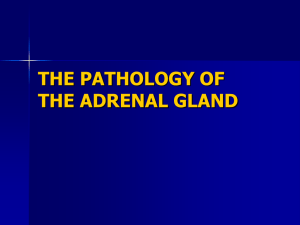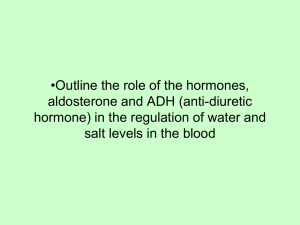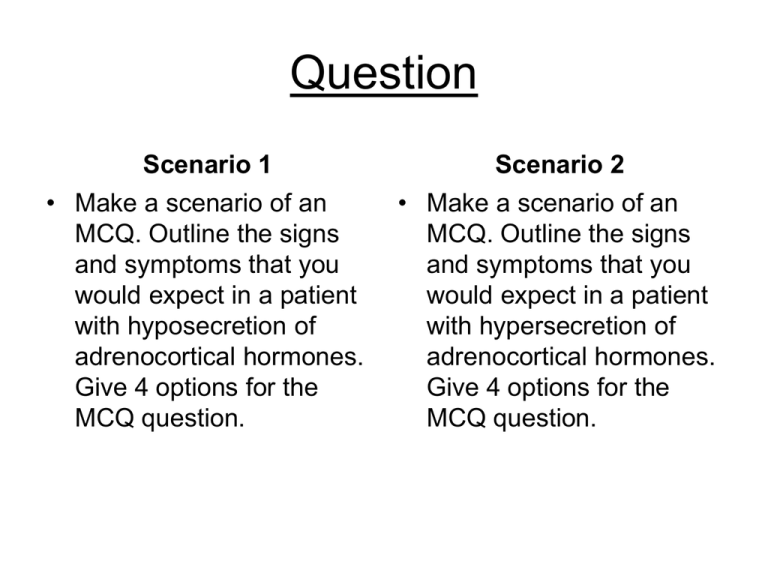
Question
Scenario 1
• Make a scenario of an
MCQ. Outline the signs
and symptoms that you
would expect in a patient
with hyposecretion of
adrenocortical hormones.
Give 4 options for the
MCQ question.
Scenario 2
• Make a scenario of an
MCQ. Outline the signs
and symptoms that you
would expect in a patient
with hypersecretion of
adrenocortical hormones.
Give 4 options for the
MCQ question.
Scenario 1
(Mian Seher Munir)
An obese 50-year old man presents with high blood
glucose levels. He shows buffalo torso and moon
face and is complaining of purple striae after injury.
The laboratory blood tests show high blood RBC’s
and relative polycythemia, hypokalemia and
hyponatremia.
He is most probably suffering from:
a.Tumour of adrenal cortex
b.Tumour of adrenal medulla
c.Pituitary adenoma
d.Increased oral steroid intake
Scenario 2
(Adil Maqbool)
A 40-year old woman presents to the physician with symptoms of:
•Swelling in the face
•Hypertension
•Excessive facial hair growth
•Abdominal fat deposition
•Polydisia
The lab results show:
•↑ levels of ADH
•↓ Na in urine
•High plasma levels of ACTH & cortisol
•↑ levels of blood glucose upto 200 mg/dl
The most appropriate diagnosis is:
a.Cushing syndrome
b.Diabetes mellitus
c.Tumor of Pituitary gland (corticotropes)
d.Conn’s syndrome
Scenario 3 & 4
Scenario 3 ( M. Halim)
A patient was presented to the
hospital having high blood
pressure. His lab tests show:
•Hypernatremia
•Hypokalemia
•High blood pH and ↓ urinary pH
Which of the following disorder is
he most probably suffering from:
a.Metabolic alkalosis
b.Diabetes insipidus
c.Hypersecretion of Aldosterone
d.Hypersecretion of Cortisol
e.Tumour of Adrenal Medulla
Scenario 4 (Mahnoor)
A woman comes into the clinic and
complains to the doctor about her
lethargicness. The doctor observes
blotches on her face along with
hypertrichosis. She complains
about being sick more than usual
and irregular menstrual cycles. Her
blood report showed ↑ glucose
levels and hypokalemia was also
observed. What do you think this
patient is suffering from:
a.Diabetes mellitus
b.Hyposecretion of ACTH
c.Hypersecretion of ACTH
d.Hypothyroidism
Scenario 5 & 6
Scenario 5 (Wadia Imtiaz)
Scenario 6 (Khizra)
A female of about 45 years presents to
the hospital with polyuria, dehrdration,
sluggishness, muscle wasting and skin
pigmentation in blotches. Clinical
examination reveals:
•Hypotension
• K levels of 7 mmol/L (Hyperkalemia)
•Mild acidosis
A person reported to the physician with
high blood pressure, muscle weakness,
nervousness, lightheadedness,
numbness and hair on the face. His lab
reports show decrease in K levels,
decreased eosinophils and basophils,
increased RBC’s and platelet count.
What is the appropriate diagnosis:
a.Addison’s disease
b.Primary atrophy of adrenal cortices
c.Primary aldosteronism
d.Cushing’s syndrome
What can be the most likely diagnosis?
a.Leukopenia
b.Hyposecretion of adrenocortical
hormones
c.Hypersecretion of adrenocortical
hormones
d.Metabolic acidosis
e.Polycythemia
Scenario 7 (Qasam)
A patient reports to the doctor of lethargic condition with polyphagia. Upon his
vital examination his/her pulse and blood pressure were low. Sexually, he/she
has slow/ decreased libido and hyposecretion of sex hormones. Upon his
urinary and blood glucose test, following are the values:
•Urine: hyperkalemia
hyervolemia
hypernatremia
•Blood sugar (fasting level): lower than 90 mg/ dl
•Blood pH: less than 7.34 (acidosis)
which hormone deficiency is possible:
a.Glucocorticoid
b.Mineralocorticoid
c.Catecholamine
d.Adrenocortical hormones
e.None of the above
Scenario 8 (Nida)
A patient reports to the doctor with edematous appearance of his
face apparently moon face with excessive deposition of fats in
thoracic and upper abdominal region. His blood pressure is also
high. On examination doctor comes to know that the patient has
excessive growth of facial hair and acne problems.
Lab reports show that his plasma ACTH & cortisol levels are
high. He also has:
•Low WBC’s
•Hyperglycemia and hyperkalemia
What would you suspect that patient will be suffering from:
a.Hypocortisolism
b.Hypoadrenalism
c.Hyperadrenalism
d.Hyperthyroidism
DISORDERS OF THE
ADRENAL GLAND
Dr. Ayisha Qureshi
Assistant Professor,
MBBS, MPhil
ADRENAL CORTEX
Hyper or Hyposecretion of
hormones of the 3 layers
may occur
Zona
Glomerulosa
Aldosterone
↑ed
CONN’s
Syndrome
Aldosterone
↓ed
ADDISON’s
Disease
Zona
Fasciculata
Cortisol
↑ed:
CUSHING
Syndrome
Cortisol
↓ed
ADDISON
Disease
Zona
Reticularis
Androgen
↑ed
ADRENO
GENITAL
Syndrome
Androgen
HYPO
secretion
Zona glomerulosa:
HYPO & HYPERSECRETION
OF ALDOSTERONE
DEFINITION:
Conn’s Syndrome is the disorder caused by the
hypersecretion of Aldosterone due to primary cause or
defect in the zona glomerulosa itself.
PRIMARY ALDOSTERONISM
(CONN’S SYNDROME)
SYMPTOMS:
1. HTN
2. Hypervolemia
3. Hypokalemia
leading to muscle
weakness &
paralysis
CAUSE:
1. Zona
Glomerulosa
Tumour
2.Hypersecretin
g adrenal cortex
PATHOPHYSIOLOGY:
1. ↑ Na & water
reabsorption leading to ↑
ECF vol. & blood vol.
2. ↑ H & K excretion
DIAGNOSIS
Primary
(Conn’s)
Aldosteronism
Secondary
Aldosteronism
↑ Aldosterone
levels
↑ Aldosterone
levels
↓
Renin-Angiotensin
levels
↑ ReninAngiotensin levels
leading to
hyperplasia of
zona glomerulosa
PRIMARY ADRENOCORTICAL
FAILURE
Causes of Primary Adrenocortical failure:
It may occur due to:
• Addison’s disease
• Congenital Adrenal Hypoplasia
• Secondary Adrenocortical failure
• Pituitary destruction
DEFINITION:
It is a disorder caused by the inability of the adrenal cortex to
produce the cortical hormones. This is frequently caused by the
primary atrophy of the adrenal cortex. The patient presents with
mineralocorticoid and glucocorticoid deficiency.
HYPOADRENALISMADDISON’S DISEASE
CAUSE:
The causes can be:
1.Autoimmune disorder
2.Tuberculous destruction of the glands
3.Cancer
4.Iron overload
Signs & Symptoms
•
•
•
•
•
•
•
•
•
•
Mineralocorticoid deficiency
Greatly decreased renal sodium
reabsorption.
Increased loss of Na, Cl & water
in the urine.
Decreased ECF leading to
hypovolemia leading to
dehydration.
Hyponatremia leading to cramps.
Hyperkalemia.
Mild Acidosis.
Hypotension.
Decreased Cardiac output.
Shock.
Death within 4 days to 2 weeks
after complete cessation of the
aldosterone production.
Glucocorticoid deficiency
•
•
•
•
•
•
Patient cannot maintain normal blood
glucose levels as no gluconeogenesis
b/w meals. Patient cannot Fast.
Nausea, vomiting, fever, diorrheoa and
anemia.
All metabolisms effected leading to
fatigue and sluggishness.
Patient highly susceptible to the
deteriorating effects of stress.
Even mild infections can lead to death.
Pigmentation of the skin in the form of
blotches b/c of increased secretion of
ACTH as feedback. These brownishblack areas appear in axilla, genital
areas, lips, buccal mucosa.
TREATMENT
• A person with complete destruction of the
adrenal may die within a few days b/c of
weakness & circulatory shock.
• However, if small quantities of mineralo &
glucocorticoids are administered daily,
they can live for years.
ADDISONIAN CRISIS
• In a person with Addison's disease, the
output of glucocorticoids does not increase
during stress. Yet whenever different types of
trauma, disease, or other stresses, such as
surgical operations, supervene, a person is
likely to have an acute need for excessive
amounts of glucocorticoids and often must be
given 10 or more times the normal quantities
of glucocorticoids to prevent death.
• This critical need for extra glucocorticoids
and the associated severe disease state in
times of stress is called an addisonian crisis.
DEFINITION:
Hypersecretion by the adrenal cortex causes a complex cascade of
hormone effects called Cushing's syndrome. Many of the abnormalities
are due to abnormal amounts of cortisol but increased amounts of
aldosterone and androgens are also responsible.
HYPERADRENALISMCUSHING’S SYNDROME
CAUSES:
• Exogenous
• ACTH-Dependant
- Pituitary adenoma
- Ectopic ACTH syndrome
• ACTH-Independant
- Adrenal adenoma
- Adrenal carcinoma
When Cushing’s syndrome is secondary to
excess secretion of ACTH by the anterior
pituitary, it is called CUSHING’S
DISEASE.
Signs & Symptoms
• Truncal Obesity
• Supraclavicular & dorsal fat
pad
• Buffalo hump (diagnostic)
• Moon Facies due to deposition
in the cheeks and temporal
area of the face, with a fish-like
mouth.
• Purple striae due to decreased
proteins in the collagen fibres.
This causes the collagen fibres
to tear easily and leads to the
formation of purple striae.
• Thin skin.
• Capillary fragility & easy
bruising.
• Hirsutism (excess facial hair
growth) and acne vulgaris–due
to increased androgens.
•
•
•
•
•
•
•
•
•
Hb percentage is raised.
Depression and psychosis.
Diabetes Mellitus also called
Adrenal Diabetes.
Severe muscular weakness due to
increased protein catabolism.
Thin extremities due to muscle
wasting and protein catabolism.
This leads to myopathy and
inability of the patient to stand up
from a sitting position.
Infections due to suppressed
immune system with impaired
wound healing.
Osteoporosis leading to frequent
fractures.
Hypertension and hypokalemia due to increased aldosterone.
Amenorrhoea.
Purple striae due to collagen
breakdown in the subcutaneous tissue:
Diagnosis
• Very challenging.
• Diagnose excess Cortisol.
• Dexamethasone suppression test: this test
helps differentiate between ACTHdependant and ACTH-independent
Cushing’s syndrome.
• Confirmation of cause.
TREATMENT
• Removal of the cause: Surgery of the adrenal
tumour OR pituitary tumour.
• Drugs that block steroidogenesis.e.g.
Ketaconazole.
• Drugs that inhibit ACTH secretion.e.g.
Serotonin antagonists.
• Partial or total adrenalectomy.
The treatment is followed by administration of
adrenal steroids to make up for any
insufficiency that may arise.
DEFINITIONS:
It is a disorder caused by an occasional adrenocortical tumor
secreting excessive quantities of androgens that cause intense
masculinizing effects throughout the body.
ADRENOGENITAL SYNDROME
SIGNS & SYMPTOMS
-
IN FEMALES
Virile characteristics in
women & girls.
Hirsutism: hair on the
face, chin and upper lips.
Deeper voice.
Occasionally baldness.
Masculine distribution of
hair on the body.
Deposition of proteins in
a masculine manner.
IN MALES
-
-
-
-
Precocious development in
boys.
In prepubertal male, a virilizing
adrenal tumour causes same
characteristics as in the female
plus rapid development of the
male sex organs.
In adult male, the virilising
characteristics are often
masked by the virilising effects
of Testosterone.
Diagnosis is made by the
presence of excess 17ketosteroids in the urine.


